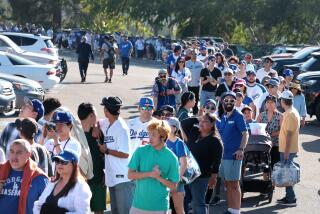Sockers Reap Benefits From Their Giveaways : MSL: Promotions credited with improvement this season in home attendance.
SAN DIEGO — Randy Bernstein, executive vice president and general manager of the Sockers, appeared to be trying to add another position to his already lengthy title: politician.
The topic of discussion was his team’s attendance, which before this season had been declining for four years. The trend has been reversed, and Bernstein was asked, why now, why not last year, why not the year before?
Bernstein started several sentences only to abort them.
He then smiled as if courting a voter and said, “You know why I’m having difficulty.”
He couldn’t find words to politely blame former owner Ron Fowler, who continued to fund the team despite absorbing six-figure losses in four years of stewardship and despite the four-year dip in attendance that coincided with his arrival.
So the politician instead chose to credit someone else, new managing general partner Oscar Ancira.
“It has been much easier to market the product this year than it has been in years past,” said Bernstein, a seventh-year Socker executive who has served three owners. “No. 1, we have a commitment from ownership, but No. 2, that new ownership is allowing the front office to carry out what we have thought all along are the right methods to market the team.”
Early results have been impressive. After six Sports Arena dates, the Sockers are averaging 10,407. If the trend continues, and the front office is confident it will, it will mark the first time since the 1983-84 season that the Sockers have averaged more than 10,000 per game. In 1983-84, the Sockers averaged 11,415 at 16 home games.
It also will mark the first increase since the 1986-87 season, when the Sockers drew an average of 9,747 to 26 home games, a slight increase of 166 from the previous season.
Further, it marks an increase of 45% over last year’s figure of 7,192 and reverses a downward spiral that began in 1987-88.
The plan that Bernstein, marketing director Tim Latta and director of ticket sales Lynn Castner have put in motion is quite simple.
They are promoting the team rather than relying on media coverage and advertising.
In professional sports, promotion means giveaways, and so far the Sockers have given away schedule magnets on opening night, commemorative trading cards of past superstars Juli Veee, Jean Willrich and Kaz Deyna on jersey retirement night, more trading cards on two youth soccer nights, hand-stitched soccer balls and lapel pins with the same face as the rings awarded to the players for winning the 1990-91 Major Soccer League championship.
That’s six home games and six giveaways.
“We’re trying to make it so that when fans come to a Sockers’ game, they feel they’re coming to more than a game--they’re coming to an event,” Latta said.
It’s a plan that has been on hold for four years.
“In the past we would go up to management with these ideas and would always get rejected,” Castner said. “We were told we didn’t see the big picture; that there were things going on behind the scenes that would soon come to fruition.”
The real problem, however, appeared to be budgetary. The league-wide trend was to trim costs in an attempt to stem runaway deficits. It didn’t make sense to cut player payrolls by $150,000 per team only to spend that money somewhere else when the ledgers were already filled with red ink. Owners instead used the savings to try to counter the tide of losses.
But the Sockers’ new ownership triumvirate brought with it a new-old philosophy: To make money, you’ve got to spend some.
So far the new ownership has committed $100,000 for promotions.
“It’s an area which demands you be a little bit more liberal in your spending,” Bernstein insisted. “In the past, if a promotion was sold to a sponsor, we were allowed to have the event. But this year we were in a position to sit down and lay out the season. And once we established the events, we went out and sold them.”
With the recent ball night, for example, Bernstein made a quantity buy of soccer balls for about $3 each. Such an expenditure would have used more than a third of the promotions budget, but Bernstein recouped the money buy selling the balls to a sponsor, which stamped its logo on the balls before giving them away.
With the exception of the championship pins, every giveaway has been paid for by a sponsor.
“But the bottom line,” Bernstein said, “is we now have a commitment from ownership that it is willing to hold the bag for $100,000, plus another $10,000 to advertise the promotions.”
Bernstein and Latta agree the promotions have been successful because Castner has directed an aggressive group-sales effort. With the exception of Friday’s championship pin night, group sales have accounted for more than 3,500 tickets each game.
“Part of it is we have had good giveaways,” Castner said. “Part of it is that the kids are playing soccer right now (in youth leagues), so we have a built-in clientele. Another part is we have a decent sales staff this year.”
Added Latta, “The bottom line is Oscar Ancira came in and made a commitment. He has realized the right people are in the right place to make this work and he has supported us instead of suppressing us.”
Sockers’ Home Attendance
Year Games Avg. Crowd 1980-81 8 4,192 1981-82 9 7,047 1982-83 24 8,081 1983-84 16 11,415 1984-85 24 9,595 1985-86 24 9,581 1986-87 26 9,747 1987-88 28 8,996 1988-89 24 8,383 1989-90 26 8,132 1990-91 26 7,192 1991-92* 6 10,407
*Note: The Sockers have 14 home games remaining this season.
More to Read
Go beyond the scoreboard
Get the latest on L.A.'s teams in the daily Sports Report newsletter.
You may occasionally receive promotional content from the Los Angeles Times.










